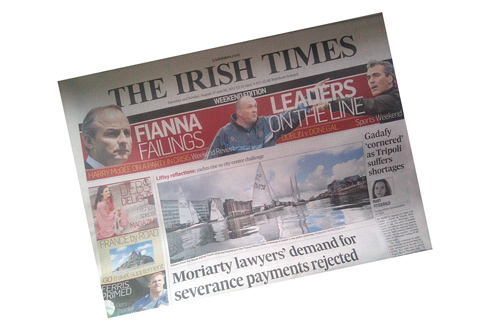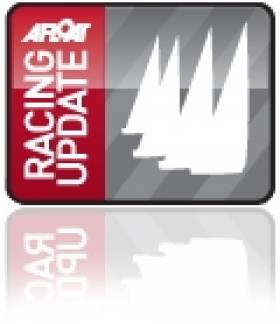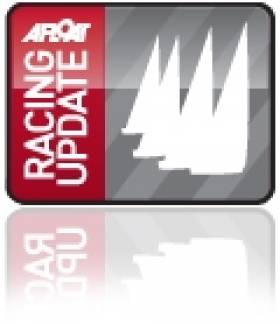Displaying items by tag: Flying fifteen
Flying Fifteens Make the Front Page
An early start for the Dun Laoghaire Flying Fifteen fleet paid off yesterday when up to eight of the 20-foot keelboats ventured from their moorings at the National Yacht Club (NYC) across Dublin Bay and up the river Liffey for the Royal Alfred Yacht Club's (RAYC) annual Liffey Challenge in Dublin's city centre.

Although there was little wind for the confined event the class nevertheless made the headlines; splashed across the front page of this morning's Irish Times newspaper. An impressive five column wide photograph captioned 'Liffey reflections' by Irish Times snapper Brenda Fitzsimons is top of the page. One no doubt that will now hang on the wall of the Dun Laoghaire clubhouse!
Racing Round up: Olympic, Fastnet, Clipper, Figaro, Dragon, J24, Fifteen, Topper, Feva, Oppy
This morning's edition includes photos and pics from Sunday's Figaro departure from Dun Laoghaire and the Rick Tomlinson's pics of the start of the Fastnet race from Cowes. Derry-Londonderry is on her way to Rio in the Clipper race. Regrettably there was no Gold, Silver or Bronze from Weymouth but we're in a strong position. See our video with Annalise here. Plus: The Topper Worlds at the National YC, John Lavery's win at the Flying fifteen South coast champs in Dunmore East, the J24 Nationals from Lough Erne, A local pair whitewashed the RS Feva Nationals in Cork Harbour, some great shots from Bob Bateman. The Oppy Nationals start in Howth and Afloat's Sailor of the Month for July Martin Byrne retained the Dragon Nationals in Kinsale. There's also the full weekend results from Dublin Bay SC.
Lavery Retains South Coast Flying Fifteen Title
Sign up and We'll Send You This Weekend's Irish Sailing News
Monday's edition includes photos and pics from Sunday's Figaro departure from Dun Laoghaire and the start of the Fastnet race from Cowes. Will it be Gold, Silver or Bronze from Weymouth? How will Peter, David and Annalise end up at the Pre-Olympics? Plus: The Topper Worlds at the National YC, Flying fifteen South coast champs in Dunmore East, the J24 Nationals from Lough Erne, Teens battle for the RS Feva Nationals in Cork Harbour, the Cove People's Regatta, The Oppy Nationals at Howth and the Dragon Nationals from Kinsale. There's also the full results from Dublin Bay SC and Howth.
Don't miss your free newsletter. Sign up here.
After finishing fifth in the penultimate race Graham Vials and Chris Turner were able to head back to HISC for an early shower after winning the 2011 Flying 15 World Championships at Hayling Island SC. The Championships closed yesterday with British boats occupying the top ten places in the 120-boat fleet. Ireland's Brian McKee and Ian Smyth from Strangford Lough finished top of five Irish boats competing in 17th place overall.
Mike Hart and Richard Rigg won the first race of the final day, second Greg Wells and Mark Darling and in third Arnaud Biet and Fabien Constant of France. Vials and Turner finished fifth to take the title with a race to spare. In the final race the 2010 champions, Grant Alderson and Dean NcAullay from Australia took the final gun. Second were Russell Peters and Tim Hall with Hart and Rigg in third.
The Classic and Silver fleets also completed their series. Bobby Salmond and Robert Till GBR627, from Holy Loch SC are the 2011 Classic Flying 15 Champions and Malcolm and Alex Hall from Burton SC took the Silver event title.
Flying 15 - Final Leaders 2011 World Championship at HISC
1. Graham Vials / Chris Turner, GBR, 21 points
2. Mike Mcintyre / Gemma Mcintyre, GBR, 41
3. Andy Mckee / Richard Jones, GBR, 44
4. Greg Wells / Mark Darling, GBR, 46
5. Russell Peters / Tim Hall, GBR, 48
6. Jeremy Davy / Simon Childs, GBR, 52
7. Mike Hart / Richard Rigg, GBR, 57
8. Grant Alderson / Dean Mcaullay, AUS, 66
9. Alan Bax / Bill Masterman, GBR, 74
10. Charles Apthorp / Gavin Tappenden, GBR, 75
Racing Round Up - Weekend Irish Sailing Review
McKee and Smyth Lead Irish hopes at Flying Fifteen Worlds
Brian McKee and Ian Smyth lead Irish hopes after five races sailed at the Flying Fifteen World championships at Hayling Island Sailing Club this morning. The Strangford Lough pair have had a consistent string of results in a mainly patchy light winds series that has threatened the two week regatta to date.
Counting 52 points McKee lies in tenth place overall, his results tally includes a race win in the opening race in the 120-boat fleet that - controversially - has been divided in to two fleets for this, the 18th World Championships.
Other Irish results include John Lavery and David O'Brien in 23rd, Peter Lawson and Barry Bridges in 40th, 59th Ben Mulligan and Alistair, Doherty, 70th David Mulvin and Ronan Beirne, Tom Murphy and Steven Lloyd in 82nd.
Racing continues until Thursday.
More on yesterday's racing from the organisers here:
Three more races in a good breeze got the Flying 15 Worlds back on schedule Sunday. Mike and Gemma McIntyre headed the list of winners with a 1, 5, 1 score line. Series leader Graham Vials and Chris Turner keep their overall lead, winning their first flight race but suffering a black flag DSQ in the final race. Other race winners were Andy McKee and Richard Jones, Russell Peters and Tim Hall, and Mike Hart and Richard Rigg.
Winners in the Classic/Silver fleet were Bobby Salmond and Robert Till in Classic GBR627 from the Holy Loch SC. Malcolm and Alex Hall, keep the overall lead and first Silver boat. First Classic overall are Gavin Cassidy and Lucy Clough.
Three more races in a good breeze for each of the flights allowed PRO Roger Palmer to get the Flying 15 Worlds back on Schedule Sunday and complete the qualifiers. The westerly breeze stayed around the 15 knots mark, providing the best day of the competition so far.
Championship leaders Graham Vials and Chris Turner keep their overall lead, winning their first yellow flight race but suffering a black flag DSQ in the final race. The day produced some dramatic place changing. The defending champions, Grant Alderson and Dean Mcaullay from Australia, resurrected their challenge with a steady 5, 5, 3, to move from 16th to second place, five points off the leaders.
[Grant Alderson and Dean Mcaullay AUS]
The Aussie pair were surprised at their overall position, Alderson describing it as a steady day, holding their position off the line and maintaining it round the course, with no big gains or losses. The elevation of Alderson and Mcaullay was balanced by their compatriots, Ron Packer and Peter Mudford, who dropped from second to finish the day in 14th.
Greg Wells and Mark Darling finished the day as they started, an 8, 6, 2 score keeping them in third place overall, six points off the lead. It was Mike and Gemma McIntyre who made the most of the day, rocketing from 27th to fourth with two race victories and a fifth. In their first blue flight race they came out the line at the committee boat end to go right. At the first mark, Mike Hart and Richard Rigg led, the McIntyres second and Jeremy Davy and Simon Childs third. McIntyre passed Hart and Rigg on the run and then held off Davy and Childs. On the next beat they went on port to the right corner and were 50 meters ahead on the reach and run and into the finish, Davy and Childs taking second and Hart and Rigg third.
In Race 2 the Irish pair, Peter Lawson and Barry Bridges port tacked the fleet and the McIntyres, who had over stood the windward mark, rounded in 12th. On the run they stayed on the right-hand side took the right-hand mark, tacked onto port and pulled themselves through to a fifth place finish.
Goacher and Evans are Flying 15 UK National Champions
After several hours of waiting and one race start for the gold fleet, which was abandoned before they reached the windward mark. PRO Roger Palmer signalled the end of racing and the British Championship was officially over. An anticlimactic end to a difficult week, which had been plagued with unseasonable summer weather from day 1. The practice race and the first two races were lost due to the storms of the opening weekend. Monday was an exciting days sailing for those who could stand the pace, big seas and strong winds providing conditions that the 15 excels in.
And those conditions were very much to the liking of defending champions, Steve Goacher and Phil Evans, as they blasted to two victories. The conditions brought to the fore a lot of familiar names, revelling in the spray and spume: Russell Peters and Tim Hall, Greg Wells and Mark Darling, Charles Apthorp and Gavin Tappenden and Australian's Grant Alderson and Dean Mcaullay, and Dave Tucker and Matt Summers. But a significant factor in the day's results was the retirement rate in the rough sea conditions and the number of black flag transgressions, something that was to be critical as the week unrolled.
Now, all thoughts turn to the Flying 15 World Championship which begins on Friday. Headed by Goacher and Evans the Britsh fleet has great depth and they are looking to return the World title, held by Australians Grant Alderson and Dean Mcaullay, to the Old Country. The strong Aussie entry plus the 28 extra boats joining the fleet for the Worlds, including additional entries from Belgium, Hong Kong, Ireland and France might just upset that plan . . . weather permitting. -- Gerald New
Flying 15 Championship of the British Isles (Pre Worlds Regatta)
Top five:
1. Steve Goacher / Phil Evans, GBR, 4 points
2. Russell Peters / Tim Hall, GBR, 6
3. Charles Apthorp / Gavin Tappenden, GBR, 7
4. Greg Wells / Mark Darling, GBR, 7
5. Jeremy Davy / Smon Childs, GBR, 8
It's been around for more than 50 years but enthusiasim for sailing's Flying 15 keelboat continues to grow. This weekend will see the start of two weeks of intense competition with the British National and the 18th running of the World Championship titles taking place. Over 100 of the Uffa Fox designed two-man keelboat will take to the waters of the Solent from the Hayling Island SC, with boats of over 40 years old competing with new boats launched for this event.
Six Irish boats are entered with the National Yacht Club represented by three boats. Dun Laoghaire's Alan Green crewing for top British sailor Charles Apthorp are listed as front runners for the worlds title. Northern Ireland's Brian McKeen and Ian Smyth represent Strangford Lough Yacht Club. Irish class president Ben Mulligan is sailing with Jay Bourke. John Lavery and David O'Brien of the National Yacht Club and David Mulvin and Ronan Beirne are also sailing. Full entry list here.
A long time favourite in Australia, New Zealand, South Africa and Hong Kong, the class has seen recent growth in Europe and this year's World Championship includes competitors from Ireland, France, Belgium and Spain. The British Nationals will form the Pre-event for the Worlds and provide a last chance to qualify, which will add an extra edge to the National Championship.
The qualifying events in the UK have seen a variety of winners including Russell Peters and Tim Hall, recent Southern championship winner, Charles Apthorp sailing with Dun Laoghaire's Alan Green. And finding a lot of speed lately at HISC, Mike McIntyre and his daughter Gemma. Multi world and national champions, Steve Goacher and Phil Evans are never far from the front when it comes to the big occasion and topped the UK qualifying.
Names to look for from the large Australian entry include defending World Champions Grant Alderson and Dean Mcaullay, and David Tucker and Matt Summers (7th 2009). From New Zealand Murrey Gilbert and Jon Burgess are in form and the Irish crews could spring an upset on the established order.
With what the Met Office describes as an unseasonably deep low affecting the UK, weather for the early part of the Nationals is expected to be rain showers with winds building to force 6 to 8 for the opening races on Sunday. The strong wind is expected to ease from Monday. The Nationals complete on Wednesday 20 July, there is a lay day on Thursday, then the Worlds start on Friday 22 July through to Thursday 28 July.
Gorman and Doorly Lift Flying Fifteen Title on Home Waters
Dublin Bay racers David Gorman and Chris Doorly have been crowned Flying Fifteen national champions tonight at the National Yacht Club after a seven race series on home waters. The Dubliners hled off a strong challenge from Northern Ireland pairings Brian McKee and Ian Smyth and Roger Chamberlian and Ian Scannell, both from Strangford Lough. The results of the last race this afternoon decided the title. 26 competed. McKee and Smith took second and Chmberlain/Scannell were third.
With no wind and racing on Friday, the Championship got under way in Dublin Bay on Saturday. In testing conditions race officer Con Murphy and his team provided four races with a further three on Sunday ensuring a full schedule.
Some of the fleet will head for the worlds in Hayling Island, Hampshire in July with the local travelling circuit continuing in Dunmore East in August and Cushendall in September.

































































